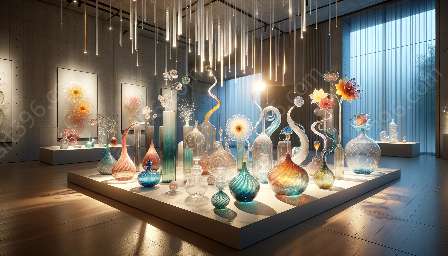Glass has been an integral part of human history and its manufacturing processes have evolved over time. Understand the environmental impact of glass manufacturing, its implications for the environment, and how it intersects with the world of glass art.
Glass Manufacturing Processes
Glass manufacturing involves several distinct processes that transform raw materials into the final glass products we use in our everyday lives. One of the most common methods is the float glass process, where the raw materials - silica sand, soda ash, limestone, and other additives are melted in a furnace at high temperatures. The molten glass is then floated on a bed of molten tin, resulting in a pristine, flat surface.
Another popular method is blown glass, a technique used in the creation of art glass. This process involves gathering molten glass on the end of a blowpipe and shaping it into the desired form with the help of breath and tools. The pressed glass process is also widely utilized, where molten glass is poured into a mold and pressed into the desired shape.
Environmental Impact of Glass Manufacturing
While glass is a versatile and essential material, its manufacturing processes can have a significant environmental impact. The extraction of raw materials such as silica sand and limestone can lead to habitat destruction and soil erosion. Additionally, the high energy requirements for glass melting and forming contribute to greenhouse gas emissions and energy consumption.
To mitigate these environmental impacts, many glass manufacturers are increasingly adopting sustainable practices. Some have implemented recycling programs to reduce the demand for raw materials, thus minimizing the impact of extraction. Others are investing in energy-efficient technologies and renewable energy sources to reduce their carbon footprint.
Environmental Impact of Glass Art
Glass art, while inherently beautiful, also has environmental implications. The processes involved in creating intricate glass artworks often involve high energy consumption and the use of potentially harmful chemicals. However, many glass artists are recognizing the importance of sustainable practices and are exploring eco-friendly approaches to minimize their environmental footprint.
Glass Art and Eco-Friendly Practices
Modern glass artists are embracing eco-friendly practices by utilizing recycled glass in their creations. This not only reduces the need for virgin raw materials but also gives a new life to discarded glass, contributing to the circular economy. Additionally, some artists are experimenting with natural dyes and pigments derived from plants and minerals, eliminating the use of synthetic and potentially harmful chemicals.
Conclusion
The world of glass manufacturing and art is evolving, with a growing emphasis on environmental sustainability. By understanding the processes involved in glass manufacturing, its environmental impact, and the intersection with glass art, we can appreciate the beauty of glass while striving for eco-friendly practices that minimize harm to the environment.

